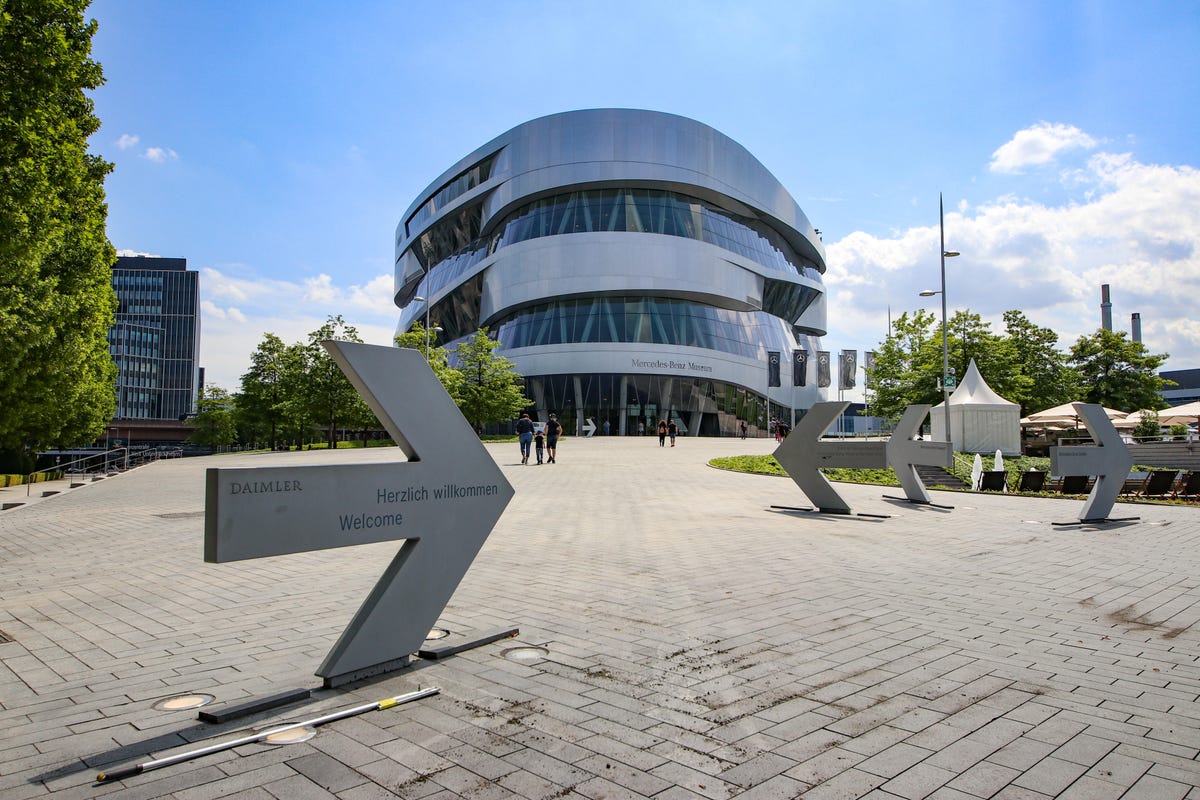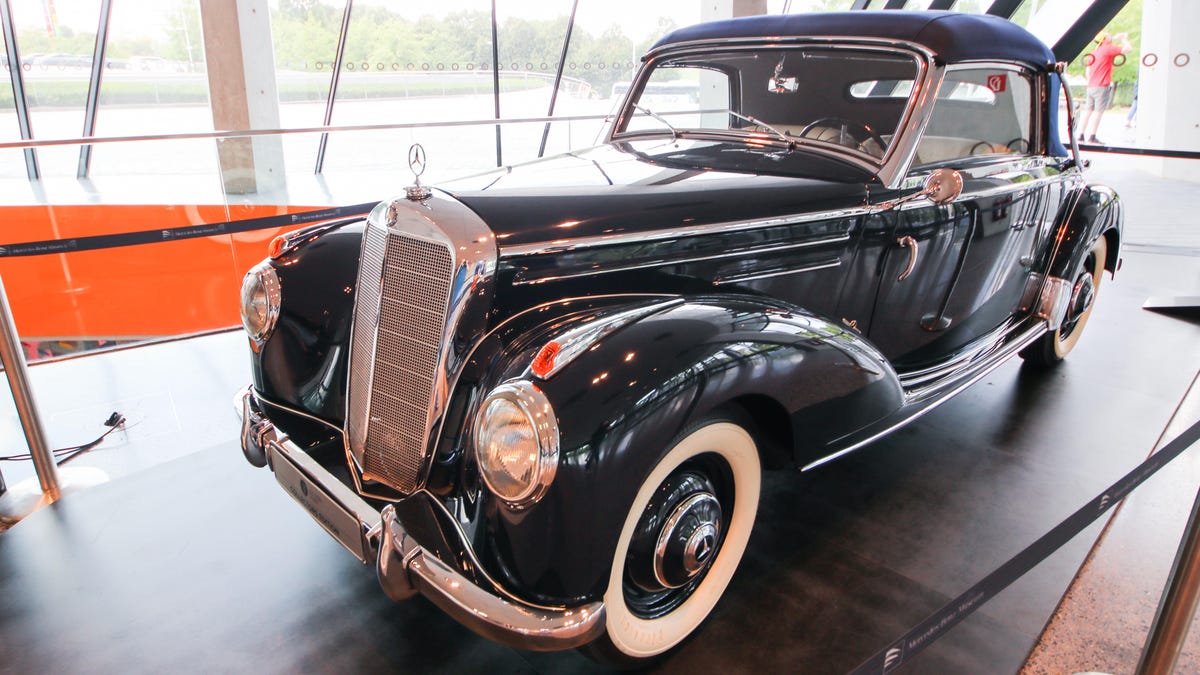Mad Mercs: Exploring Stuttgart's Mercedes-Benz Museum
Over 130 years of Mercedes history at this incredible museum in Stuttgart, Germany. Here's a look inside.

Mercedes-Benz Museum
Located not far from its headquarters, in Stuttgart, Germany, the Mercedes-Benz Museum celebrates over 100 years of automotive history.
For more about this museum and our tour, check out Gullwings and racing legends at the Mercedes-Benz museum.

Standouts
In the lobby, and downstairs near the cafe, there are some immaculate classics on display you can actually buy. Exit through the gift shop, indeed. This is a 1953 single-owner 220A Cabriolet.
Wankel atrium
The entrance foyer, where you wait for an elevator, is designed like the inside of a giant Wankel rotor.
Glass and steel
I was not expecting this. It's easily the most beautiful entrance to an automotive museum I've ever seen. The horse ignored me. How rude.
Beginnings, by Kubrick
The beautiful design continues as you enter the exhibits. Logically, it starts with the first self-powered vehicles. The very first "car" was invented by Karl Benz in 1886, a replica is seen here on the left. On the right, Gottlieb Daimler and Wilhelm Maybach's Motorized Carriage, which first ran a few months later. In the foreground, Daimler's single-cylinder internal combustion engine that made it all work.
Curves
The museum has a clever layout, with a sort of double-helix floor structure. This maximizes exhibit space, though you have to be careful to see everything on each helix side before you descend to the next group of floors.
Touring Limo
Car design evolved rapidly. This is a 60-horsepower Mercedes Simplex from 1904, featuring a touring limousine body that was fitted to the chassis in 1907.
Oldest Mercedes
This is the oldest Mercedes-branded vehicle in existence, a 40-hp Mercedes Simplex from 1902.
Rad
One of Mercedes' important early inventions was the honeycomb radiator, which greatly increased the surface area of the radiator to improve engine cooling.
Other side
While one helix tells a roughly chronological progression of the history of Mercedes, the other groups together cars into a specific theme. This is the Gallery of Voyagers that highlights some of the many buses, limos and long distance cruisers built by Mercedes over the decades.
The silver beauty is a 300 SEL 6.3 from 1972.
Bus of many colors
This painted bus was built in Argentina and painted by its owner, like many Colectivos in Buenos Aires.
Double up for London
Some early London double-decker buses used Mercedes truck chassis built in Germany with bodies built in England. This example, from 1907, was used by Vanguard, which would get bought out by the London General Omnibus Company.
Collection 2
Before heading back to the "timeline" helix, I checked out the next Collection down, the Gallery of Carriers, Mercedes trucks designed to haul all sorts of things. This, for example, is a mobile post office from the 1930s.
Merc-ception
A Mercedes carrying multiple Mercedes.
Streamlined transporter
One of my favorite vehicles at the museum, this weird looking oddball is a 1955 high-speed race car transporter, a Rennwagen-Schnelltransporter. The original prototype was presumably destroyed, so this one was built more recently using the original blueprints. Top speed was 106 mph.
Super sport short
The Super Sport Kurz, or "short" was a shortened wheelbase version of the Model S, designed for hillclimb racing in the late '20s and early '30s. It was designed by Ferdinand Porsche.
10/40
The 10/40, seen here, and its sister model the 6/25, were the first production cars to feature superchargers.
Brisk touring
With the supercharger engaged, power output from the 2.6-liter inline-4 was an impressive, for the day, 64 hp.
50s
Now we're starting to get to the iconic stuff.
Gullwing excellence
The 300 SL is probably the most famous Mercedes, and certainly one of the coolest cars of all time.
Lavish red
Not too often you can get this close to one. The steering wheel folds down to aid access over the wide door sills.
300 S
It's hard to believe, but this very 30s-looking coupe was launched new only three years before the 300 SL Gullwing.
Roadster
The Gullwing was replaced in 1957 with the 300 SL Roadster. Perhaps not as epic, with its regular doors, but still quite gorgeous.
Almost racer
Mercedes stopped racing before the hardtop 300 SLR could tear up a track in anger. The head of the racing program used it as his personal vehicle instead. Interestingly, the clutch is on one side of the bellhousing/driveshaft tunnel, the brake and gas on the other, meaning you had to drive with your legs splayed wide. Hope there wasn't much traffic on his commute.
Gallery of Helpers
Over in the Gallery of Helpers there's a collection of special-purpose vehicles, starting with this 1952 170V panel van which was used as a mobile workshop for Mercedes service teams.
Polizei
This police station wagon was based on the late-'90s C-Class. The police cars of this era were painted silver and green to make it easier to eventually resell them.
Boxy
Not sure I've ever seen a garbage truck in a car museum before. Admittedly, it's pretty cool looking. It's a 2005 Econic NGT 2628 powered by a 275-horsepower, 6.9-liter 6-cylinder natural-gas engine.
Boxy
This section highlights their safety and testing innovations.
Testing on the move
In order to get accurate and useful measurements while a car was in motion, in an era of limited computer and wireless technology, Mercedes connected two cars with a wire bundle umbilical and drove them together around a track.
One of a kind
The testing wagon, based on the W189 series, was custom built for the testing department and despite all the weight of the extra instruments and equipment could still get up to 103 mph.
Pagoda
The iconic '60s 230SL Pagoda is featured in this section because it was the first sports car to have crumple zones, something all cars have now.
Emperor's limo
The chrysanthemum on the rear door gives a hint about who owned this 1935 770 Pullman: Japanese Emperor Hirohito. The doors and roof were armored, and the glass was extra thick.
Fuel efficiency
This exhibit featured MB's efforts toward fuel economy over the years. The lovely and boxy Auto 2000 wagon seen here featured a body with a low drag coefficient of 0.28, and was used as a test bed for three engines: a V8 with cylinder deactivation, V6 turbo-diesel, and a gas turbine. All were promising tech in 1981 when the car was built.
Electric boogaloo
A 2012, all-electric variant of the SLS coupe, called the SLS AMG Electric Drive. Fewer than 100 were sold.
Slick proto
The Concept IAA has a drag coefficient of 0.19. That's impressive for any car and especially so for a big sedan. The lack of side mirrors likely helps.
Evo II
Though always overshadowed by the faster (better?) M3 of the era, the 190E 2.3-16V is still quite impressive, especially in wide-body 2.5-16V Evo II form. That rear wing though...
Comfort cruise
Under the hood of the 220S is a 2.2-liter inline-6 with around 100 hp.
Race
Mercedes has a long history in motorsport. The exhibit celebrating these race machines is one of the most impressive at the museum. A huge curved display that wraps almost completely around the museum.
Hang tight
There's something more than a little alarming about seeing a massive truck hanging at such an angle. This is a 1450S, the first generation of MB racing trucks. The 18.3-liter V10 developed 1,578 hp and powered it to many victories.
Winner
The W07 Hybrid won 19 of 21 races in 2016. It helped Nico Rosberg win the Drivers' Championship and Mercedes win the Constructors' Championship that year.
Streamliner
Driving a W196 with its new streamlined "Type Monza" body, Juan Fangio and teammate Karl Kling came in first and second at the 1954 French Grand Prix. The following year, Fangio won the Championship in a slightly improved version, seen here.
Legendary
In this 300 SLR, Stirling Moss won the 1955 Mille Miglia in the fastest time in the history of the race. A record that still stands. 722 was the start time: 7:22 a.m.
From the ashes
The Daimler Phoenix featured a heavy, high-mounted engine that made it difficult to control. It's said that after a crash, Daimler designed the car that would become the first proper Mercedes.
An experiment with angles
The experimental C111-II from 1970. Only 16 C111s were built, with a variety of engines. This version had a four-rotor Wankel.
Finned
Designed to set speed records using the turbo diesel engine that would appear in their upcoming models, the C 111-III set nine world speed records in the late '70s.
Crossing the finish line
What a view to end on. It's a rare car museum that has such impressive architecture to compliment the vehicles within. Definitely worth a visit if you're in southwest Germany.
For more about the museum, and the incredible cars throughout, check out Gullwings and racing legends at the Mercedes-Benz museum.

